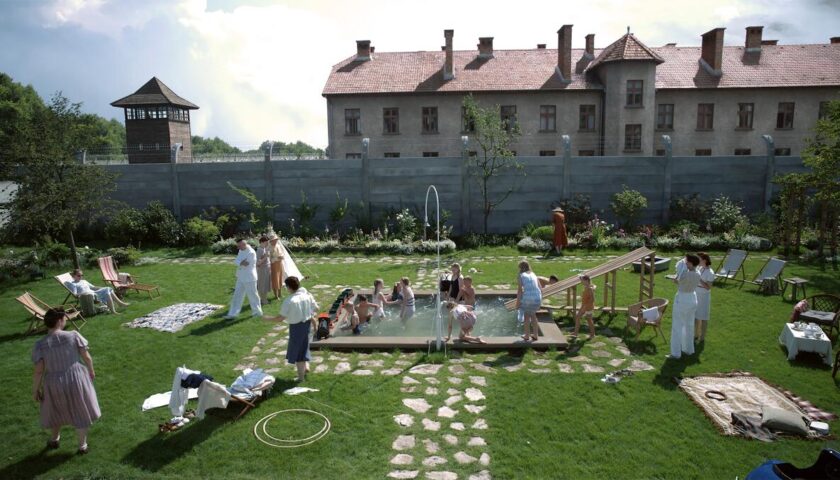“The Zone of Interest” (2023) – “Bye, bye, Daddy.” – Hedwig (Sandra Huller)
The morning arrives, and Rudolf (Christian Friedel) prepares for his workday, possibly a Monday.
He climbs on his horse and will move through an open gate, as his workplace is adjacent to his home, separated by only a wall. While holding their infant, Hedwig casually throws out the affable goodbye, adieu, or tschüss, tschüss to Rudolf.
Rudolf and Hedwig Hoss are not an ordinary suburban couple living in Chandler, Ariz. or Orlando, Fla.
It’s 1943, and the pair and their children live in Poland. More specifically, they reside – literally – next to the Auschwitz concentration camp, and Rudolf is the commandant. The man runs the place, a horror show where 1.1 million people died (and nearly 1 million were Jewish) during WWII.
Writer/director Jonathan Glazer (“Sexy Beast” (2000), “Under the Skin” (2013)) brings this sinister history to the big screen in “The Zone of Interest”, adapted from Martin Amis’ 2014 book with the same title.
Glazer’s surreal creation is unlike any other Holocaust movie (at least that this critic has seen) because the picture takes a voyeur’s perspective of the Hoss family as they go about their day-to-day activities from behind the scenes, behind closed doors, as friends visit for tea, the family celebrates a birthday, housekeeping chores occupy the busy maid’s time, and Rudolf and Hedwig share pillow talk.
During a TIFF Sept. 10, 2023 screening, Glazer called his film – and he may have been quoting someone else – “’Big Brother’ in a Nazi house.” This critic calls “Zone” chilling, haunting, and a movie that deserves Oscar nominations for Best Picture, Director, Cinematography, and Sound.
Their lavish locale, a spacious domicile and bountiful grounds – complete with a pool and a garden with sunflowers and kale – occupies the vast majority of the film’s 105-minute runtime, where life flourishes. Meanwhile, well-documented atrocities occur just over the adjoining wall. Rather than visually display the murders, Glazer painstakingly films the camp from the Hoss’ perspective. The tops of the brick-and-mortar housing quarters and “offices” ominously tower over the aforementioned concrete divider while Hedwig proudly praises her garden to her visiting mother and where her kids randomly play.
For other select moments, Glazer will present the active chimney of the camp’s infamous furnace during the bright daylight hours and in the middle of black evenings, when it ferociously glows with a burning orange.
Our ears burn too, as we frequently hear screams and gunshots, but (almost) no one on the Hoss estate acknowledges the gruesome clatter because the house needs cleaning or dinner will shortly commence.
Due to the movie’s bizarre observation of this time and place in history, it becomes a challenging chore to grasp the on-screen events. What is Glazer presenting here?
Indeed, the face of evil is on display; however, during the Jan. 16, 2024 Q&A of “The Zone of Interest” Phoenix Film Society screening, one society member opined that we’re looking at indifference as well.
Indifference.
Indifference to the sounds of suffering and bullets, the smells of burning bodies, and the nature of Rudolf’s business. The latter reveals itself through Rudolf and Hedwig’s discourse of his career aspirations and a composed engineer describing Auschwitz’s efficiencies to an attentive Nazi audience, to name a couple.
No, indifference is not the emotion you will feel when held captive by “The Zone of Interest”.
![]()
![]()
![]()
![]() out of
out of ![]()
![]()
![]()
![]()
Directed by: Jonathan Glazer
Written by: Jonathan Glazer, based on Martin Amis’ book
Starring: Christian Friedel and Sandra Huller
Runtime: 105 minutes
Rated: PG-13
Image credits: A24






